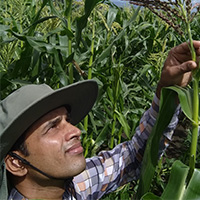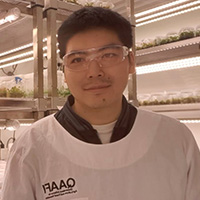QAAFI's APBC students present the potential value of their research for the industry in advance of the upcoming Australiasian Plant Breeding Conference.
 Shanice Van Haeften
Shanice Van Haeften
Presentation title: UAV phenotyping to advance mungbean research and breeding
Mungbean is an important pulse crop that provides a high-quality plant protein source for consumers and being a major high-value export crop for Australian growers. While substantial yield improvements have been made, the rate of genetic improvement in mungbean could be further advanced by overcoming the phenotyping bottleneck that exists due to the constraints of traditional phenotyping methodology. Unmanned aerial vehicles (UAV) imaging platforms are evolving as a powerful phenotyping tool to rapidly evaluate canopy traits at a large scale, however their potential to advance mungbean research is yet to be explored. This study investigated the ability of UAV-based imaging to identify and dissect the physiology and genetics of promising traits that are correlated with yield. By comparing UAV-based traits to ground-based measures of important physiological and agronomic traits, this study highlights the opportunity for modern mungbean crop improvement programs to exploit traits derived from high-throughput phenotyping approaches.
 Apurba Anirban
Apurba Anirban
Presentation title: World-first purple shrunken2 sweetcorn development as a naturally nutritious crop
Novel purple sweetcorn (A1A1.sh2sh2) was developed by crossing a white sweetcorn (a1sh2.a1sh2) with a purple non-sweet maize (A1Sh2.A1Sh2), followed by several field experiments. SSR molecular marker assay followed by genomic study revealed the presence of A1 (anthocyanin1) structural as well as Myb transcription factor (TF) Pl1 (purple plant1) and bHLH TF R1 (coloured1) genes for anthocyanin development, with sh2 (shrunken2) gene for sweetness. The developed purple sweetcorn produced a similar anthocyanin concentration as in its purple maize parent, and sugar as in its white sweetcorn parent. This world-first purple shrunken2 sweetcorn will fulfill consumer demand of naturally nutritious healthy crop.
 Yuxin Xue
Yuxin Xue
Presentation title: Polyploid development for a better scopolamine content in Duboisia species
Polyploid development for a better scopolamine content in Duboisia species
Abstract: Duboisia is an Australian native species used for commercial cultivation of the active ingredient scopolamine for pharmaceutical industry. The Australian Duboisia industrial value equates to AU$100 million with a high scope for development. Elite selections of Duboisia hybrid can accumulate 6% of scopolamine by dry weight. The industry is desperate for new breeds with higher scopolamine content to satisfy the increasing demand. Ploidy manipulation provides a powerful tool for crop improvement. Stable polyploids often result in phenotypes of large leaf/plant size, thus better biomass in plants. Polyploid development through protoplast fusion followed by true to type plant regeneration, exploiting tissue culture provides an alternative breeding strategy for Duboisia improvement.
For any questions, please contact the QAAFI Science Seminar Committee.
About Science Seminars
Queensland Alliance for Agriculture and Food Innovation hosts science seminars across the disciplines of animal, horticulture, crop, food and nutritional sciences.
With a range of speakers from Australia and abroad, the series explores how high-impact science will significantly improve the competitiveness and sustainability of the tropical and sub-tropical food, fibre and agribusiness sectors.
View Science Seminar pageSign up to receive QAAFI Science Seminar notifications
Email Science Seminar Committee
The Queensland Alliance for Agriculture and Food Innovation is a research institute at The University of Queensland, established with and supported by the Queensland Department of Primary Industries.
Venue
https://uqz.zoom.us/j/86305573673
